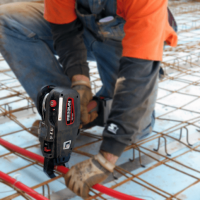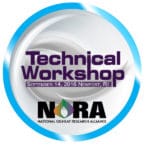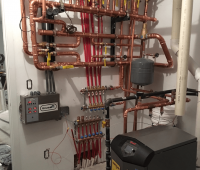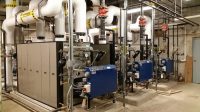The PEXGUN is an automatic, compact and economical tool to attach PEX pipe to rebar and wire mesh in less than one second flat. Simple one hand operation reduces potential risk of carpal tunnel injuries and using the optional extension arm prevents bending over and potential back aches. Just pull the trigger and the PEXGUN Read more
Whats Next

 The PEXGUN is an automatic, compact and economical tool to attach PEX pipe to
The PEXGUN is an automatic, compact and economical tool to attach PEX pipe to
rebar and wire mesh in less than one second flat. Simple one hand operation
reduces potential risk of carpal tunnel injuries and using the optional extension arm
prevents bending over and potential back aches. Just pull the trigger and the
PEXGUN wraps smooth galvanized wire around PEX pipe to make a secure tie. The
PEXGUN is 5x’s faster than plastic zip ties, 3x’s faster than plastic staples and
absolutely save you time and money!


On Sept. 14th, the National Oilheat Research Alliance (NORA) will hold a Technical Workshop in Newport, Rhode Island in conjunction with the Southern New England Energy Conference*. This is the first NORA Technical Meeting following their reauthorization and it is a great opportunity to share detailed information on the latest results of the NORA research Read more
On Sept. 14th, the National Oilheat Research Alliance (NORA) will hold a Technical Workshop in Newport, Rhode Island in conjunction with the Southern New England Energy Conference*.
This is the first NORA Technical Meeting following their reauthorization and it is a great opportunity to share detailed information on the latest results of the NORA research projects and other technical developments.
Major topics planned for the Workshop include: biofuels, fuel quality, combustion/burners and efficient systems and controls.
As of this release, the program is a follows. Additional topics and speakers may be added in the future.
 The Conference venue is the Hotel Viking, 1 Bellevue Ave., Newport, R.I. Rooms will be $239 per night. They will be reserved at 800-556-7126 and reservations should be made by August 14, 2016.
The Conference venue is the Hotel Viking, 1 Bellevue Ave., Newport, R.I. Rooms will be $239 per night. They will be reserved at 800-556-7126 and reservations should be made by August 14, 2016.
To register for the conference, please RSVP here. This will ensure your spot is reserved for the conference.
Proceedings will be published and speakers will need to submit at least a short paper. At present, NORA is fully open to presentation proposals. For additional information contact Dr. Tom Butcher at tbutcher@noraweb.org.
Those interested in presenting a paper at the workshop should submit an abstract as soon as possible by email to Tom Butcher. Presentations proposals will no longer be accepted when all slots are filled.
* September 12-13 is the Southern New England Energy Conference, the annual conference for the Oilheat Institute of Rhode Island, the Connecticut Energy Marketers Association, and the Massachusetts Energy Marketers Association.
For more information about NORA and its programs or services, call 703-340-1660 or visit the web site, www.NORAweb.org.

When Jason Ridgeway of Ridgeway Home Services, West Chicago, Ill., says he takes pride in his work because “we like what we do,” it’s pretty evident in his installations. Recently, at a new construction custom house in the trendy Wrigleyville neighborhood, the homeowner asked for a hydronic snowmelt system and hydronic floor heating. Ridgeway Read more
When Jason Ridgeway of Ridgeway Home Services, West Chicago, Ill., says he takes pride in his work because “we like what we do,” it’s pretty evident in his installations. Recently, at a new construction custom house in the trendy Wrigleyville neighborhood, the homeowner asked for a hydronic snowmelt system and hydronic floor heating.
Ridgeway installed REHAU under floor metal plates with 1/2″ REHAU o2 barrier pipe. This allowed for the added floor radiant and even heat distribution with out adding to the floor height. The 2-man crew also added a 80-gallon indirect hot water heater and even snowmelt to the project in the front and back porch areas as well as walkways. Ridgeway custom built a hydronic panel to tie this all in.

Since this was a new construction site, the electrician had not been there to install power. “We had to get this up and running in order to heat floors so the flooring contractor could put down his floor which he would not do without floor heat running even though the furnaces have the place heated to 75 degrees. The electrical wires in the pictures are just temped in to a outlet until Sparky finishes,” says Ridgeway.

Ridgeway has a purge set up on the panel so they can purge all radiant floors from one location. “This entire system is filled with glycol so we want to switch hoses as little as possible,” says Ridgeway.
Some of the challenges were that the mechanical room was very small to begin with and now they are adding a boiler as well as piping and an indirect tank. “Things where very cramped,” says Ridgeway.
Quick Notes:
• According to Ridgeway, we have a boiler pump for the boiler on closely spaced tees. There’s a snowmelt pump not installed yet that will be over the door and a indirect pump for the indirect heater not installed yet. Then we have the one pump you can see which will actually be replaced with a Grundfos Magna series pump due to the multiple zones. We typically use the low loss headers but did not on this job.

• Balancing is done at the REHAU PROBALANCE manifold for the floor radiant. Temperatures are balanced with motorized mixing valves and HTP VISON 2 control Zones by Caleffi zone control.
• ProPress is great. I solder and braze with the best of them. I have done everything from 4″ massive boilers and chillers pipe work to 1/2 plumbing and no issues and no leaks. With a 20-year track record and 10s of thousands of fittings.
• All this and we’re allowed only 4 feet of wall in which to install. Not shown yet is the domestic hot water that’s going to be installed in front of the manifolds between boiler and panel.
• Zip ties are temporary until the clevis hangers show up; they did a great job holding pipe straight while they put it in.
 • Snowmelt — we install tubing in the driveway, walkway and stairs and pump hot water through it from a boiler. The concrete then gets to a set-point temp above 32 degrees and melts the snow and ice on the drive turning it into water then vapor. This way no salting, plowing or shoveling is needed.
• Snowmelt — we install tubing in the driveway, walkway and stairs and pump hot water through it from a boiler. The concrete then gets to a set-point temp above 32 degrees and melts the snow and ice on the drive turning it into water then vapor. This way no salting, plowing or shoveling is needed.
Energy Savings:
Two furnaces and ac systems are both 2 stage 17 seer
Boiler — Lochinvar knight 211,000 (97% efficient)
Water heater —Lochinvar indirect
Location: Chicago Ill. — Wrigleyville
Date started: Jan 18 2015
Date Finished: Projected date to finish July 20th
Size of Project: 6,000-sq ft-home
Workers onsite: 2
Budget: $68,000.00

When Temple Baptist Church in, Pueblo, CO, needed to replace their oversized, antiquated boilers, they called Moose Plumbing & Heating. Jason Mulso – whose friends call him “Moose” – started the company in 2005. He and his two employees serve southern Colorado. Residential work is the focus, but they do enough commercial work to keep Read more
When Temple Baptist Church in, Pueblo, CO, needed to replace their oversized, antiquated boilers, they called Moose Plumbing & Heating.
Jason Mulso – whose friends call him “Moose” – started the company in 2005. He and his two employees serve southern Colorado. Residential work is the focus, but they do enough commercial work to keep it interesting. Churches, car dealerships and the occasional large home break up the steady flow of 100 MBH boiler installs.
“It’s a big church,” said Moose. “But at roughly 13,000 square feet, it’s not 1.8 Million BTUs big, which is what they had installed when we arrived. A heat load calculation called for around 1 million.”
In addition to wrestling the big old units out of the building, they also had to design a distribution system that could handle some level of hydronic fluid impurities while accommodating the extensive zone valves scattered around the building. Because efficiency was a key concern, his plan was to use a dual, modulating boiler approach and variable-speed circulation.

Moose P&H installed two, 500 MBH Burnham Alpine boilers during a retrofit at a church in Pueblo, Colo.
Less is more
Once they’d gotten approval to start, the Moose crew pulled out the existing boilers and installed two new, stainless steel Burnham Alpine boilers. The new, smaller condensing units are daisy-chained together to fire in lead-lag configuration.
“The Alpines at the church rarely – if ever – both reach high-fire simultaneously,” said Moose. “We use the Alpine a lot on residential work, so it’s fun to install the big ones when we get a chance. Aside from having to roll them into place, they’re easy to install, just like the wall-hung models.”
Burnham’s high-efficiency Alpine line recently expanded with the addition of several large sizes. The unit is now offered with capacities from 80 to 800 MBH.
In addition to heating the structure, the common primary boiler loop feeds two, 60 gallon indirect water heaters. One tank provides domestic hot water to the entire building, while the other is dedicated to a small baptismal pool at the front of the sanctuary.
Pumping smarter
The original church was built in the early 1900s. A number of additions spanning the decades made the hydronic system a bit more complex. An assorted mix of convectors, fan coils, fin-tube and cast iron radiation is used.
The saving grace however, was that each zone is controlled by a remote zone valve, all of which are operational. The system was divided into two sections – or secondary loops, so to speak. The nursery and sanctuary make up one of the sections, while school rooms, a cafeteria and gymnasium are on the other.
“I worked with a rep at McCoy Sales to select the right circulators for the two areas of the church,” said Moose. “The load varies greatly depending on the activities going on in the building. So we needed a high-head, high-flow pump with the ability to vary its speed considerably, and do so without a control system or remote pressure sensors.”
McCoy suggested a Taco 00e Series VR30 for each loop. Based on an internal pressure sensor, the web-enabled commercial circulator ramps up and down as needed to match the pump curve to the system curve at all times. It also offers up to 85 percent electric savings over conventional circulators of similar capacity.
“We use Taco on all of our hydronic systems,” said Moose. “The VR30 is the biggest circulator we’ve installed in quite a while, but even if just one zone is calling, the pump is providing the correct flow rate. And there are no more banging zone valves as a result of an over-pumped system.” Because of the old system piping and radiation, a large Taco 4900 Series air and dirt separator was also installed.
Heavenly improvements
Moose P&H worked off and on for three weeks to complete the job. Each day began with a 40 mile commute from their shop in Cañon City. But the result of their hard work was beyond what the church had hoped for.
“Fuel consumption over the first three months was down by 35 or 40 percent,” said Moose. “But, before they even saw the gas savings, they felt a big change at the front of the church.”

Temple Baptist, a 13,000-sq.-ft. church in Pueblo CO, was in need of a boiler retrofit and smaller energy bills.
The baptismal pool was far more comfortable than they’d ever experienced. It turns out, when you remove an old, 40-gallon gas-fired water heater and replace it with 1 million BTUs of boiler capacity and a sidearm tank, you can generate hot water a little more quickly!
Products & Tools
Boilers: Burnham Alpines, 500 MBH
Sidearm tanks: Burnham Alliance, 60 gallon
System pumps: Taco 00e Series VR30
Boiler pumps: Taco 2400 Series
Expansion tank: Taco CBX, 125 gallon
Strainer: Taco 4900 Series air & dirt separator
Ball valves: NIBCO
Tools: Rigid pipe cutters, pipe threader

With failing oil-fired boilers and an aging, inefficient heating system, Elm Street School in Gardner, Mass., turned to modulating boilers from Weil-McLain to spark energy efficiencies and lower heating costs for the school. Built in 1923, Elm Street first served as a high school, but over the course of numerous years, the district converted the Read more
With failing oil-fired boilers and an aging, inefficient heating system, Elm Street School in Gardner, Mass., turned to modulating boilers from Weil-McLain to spark energy efficiencies and lower heating costs for the school.
Built in 1923, Elm Street first served as a high school, but over the course of numerous years, the district converted the facility into an elementary school. Today, the 130,000-square-foot facility houses more than 500 students.

“Our heating system consisted of two nearly 20-year-old boilers that were in constant need of repair,” said Robert O’Brien, director of facilities for Gardner Public Schools. “We found ourselves changing out cast iron sections on an annual basis. In addition to the maintenance issues, we wanted to decrease our overall heat load.”
To assist with project funding and help cover boiler replacement costs, the school applied for and received a green repair grant from the Massachusetts School Board Authority (MSBA). The MSBA Green Repair Program offers districts the opportunity to repair or replace roofs, windows and/or boilers in public school facilities that are otherwise structurally, functionally and educationally sound.
With funding in place, the school selected, MacRitchie Engineering, based in Braintree, Mass., which provides HVAC, plumbing and electrical design services, to handle the boiler replacement.
“We sought a dual combination gas and oil commercial boiler and Weil-McLain was my primary choice,” said O’Brien. “We also wanted units with the ability to modulate with a control package that could be implemented into a building management system.

“We received three competitive offerings when the project was put out for bid and we chose Weil-McLain because the equipment had the best load matching characteristics,” said O’Brien.
The team chose three Weil-McLain 88 Series low pressure steam boilers as the optimal choice to match heating load requirements with two carrying the building load and one installed for redundancy. MacRitchie also was tasked with handling oil conversion to add gas for dual fuel firing, boiler room valves, boiler feed unit, fuel oil pumps and controls, and associated electrical and plumbing work.
The Weil-McLain 88 Series boilers offer up to 85.7% thermal efficiencies, are operational in single or multiple systems as gas, oil or gas/oil, and feature modulation control.
The old oil-fired burners were removed and replaced with the Weil-McLain dual fuel boilers and configured with gas as the main fuel source and oil as a backup. Each boiler was installed with its own pump plus a common manually valved standby pump.
The project was completed and the units were placed in operation in October 2015.
Numerous benefits realized
According to O’Brien, the installation went smoothly and the school already is experiencing benefits.
“We expect to save anywhere from 20% to 25% of our fuel costs with these new boilers because they are more energy efficient, feature low-range pressure controls and have the ability to modulate,” said O’Brien.
Modulating burners are designed to control the burner output to match the boilers’ variable load requirements to ensure maximum combustion and boiler efficiencies during large heating demands. The modulation feature also has decreased the system pressure.
“Thanks to modulation, we reduced the amount of operating pressure from about 10 pounds on a cold day to about 5 pounds,” said O’Brien. “Dropping the pressure created a lot of savings, yet we are still maintaining the temperature inside the building so that’s a definite plus.”
Other benefits O’Brien and building staff are realizing include the adoption of a building management system that will send notifications via email and sound an audible alarm in the school if an issue should arise.
“If a boiler burner should misfire, for example, I immediately get an email and an audio alarm goes off in the school,” said O’Brien. “This alerts school custodian staff that an issue is happening, and it’s an important safety feature to have.”
The expected duration and life of the boilers are another plus, according to O’Brien.
“The life expectancy is typically 30 or more years for these boilers,” he said.





